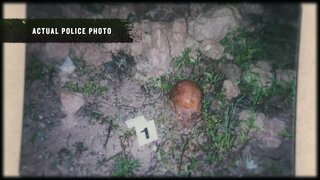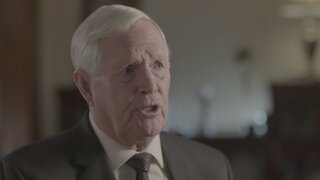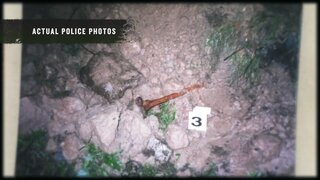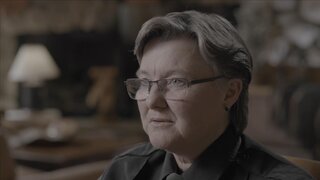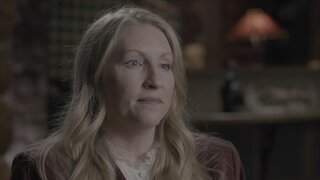Create a free profile to get unlimited access to exclusive videos, breaking news, sweepstakes, and more!
Michigan Man Abducts Teen Boy In Van With 'Don't Let Your Child Go With Strangers' Bumper Sticker
Randy Laufer was missing for 10 years before his body was found and a sadistic killer was exposed.
In the fall of 1987, a teenage boy’s unexpected disappearance opened a community’s eyes to a sadistic killer who was closer to home than anyone in the quiet town of Harrison, Michigan ever expected.
Siblings Kandy and Randy Laufer were heading home from school one uneventful day in September when their lives changed forever. While Kandy got on the school bus as usual, she noticed her 15-year-old brother heading through the school parking lot and toward the street. Earlier, he had told the family that he was spending the night at a friend’s house, so she didn’t think anything of it.
The following morning, parents Bob and Lois Laufer received a call from the school informing them that Randy had not shown up for class. They then found out he had never made it to the sleepover.
Still, the family didn’t panic just yet, as it wasn't unusual for Randy to seek time alone.
"Sometimes Randy used to go off to get a little attention. I thought maybe he just had gotten mad at something and had just decided to strike out on his own," Randy’s aunt, Lynn Laufer, told “Buried in the Backyard,” airing Thursdays at 8/7c on Oxygen.
After the family reached out to various friends and relatives, however, and learned that no one had seen or heard from Randy, they began to worry. They quickly called the police to report that their teenage son was missing.
The Laufers told authorities that Randy had recently been upset because his father had refused to take him to a hunter safety class, and they suspected that maybe he'd gone off by himself in the woods in an act of rebellion. Unfortunately, despite their suspicions that Randy had run away, days passed with no answers, and the Laufers grew more and more concerned.
Police interviewed Randy's friends at school, but they were no closer to finding out where he'd disappeared to until a neighbor, upon hearing that Randy was missing, called to report a disturbing incident that occurred a few days prior.
The neighbor been in downtown Harrison when they saw Randy in the passenger seat of a van being driven by an adult male. Randy had waved to the neighbor, who observed the van driving south out of town.
"That was the last anyone ever saw of Randy," Mark McMellan, a detective with the Clare County Sheriff’s Department, told producers.
Authorities were unable to track down the van in question, however, and the investigation continued. Concerned loved ones put up missing person flyers with Randy’s picture, and his photo was printed on the side of milk cartons.
As the Laufer family and authorities searched for answers, Randy’s mother began to theorize that due to her son’s love of clowns and carnivals, he’d run away to join the circus. Coincidentally, a carnival had been in town at the time of Randy's disappearance, but after looking into it, authorities found no evidence that Randy had connected with the group.
"Hope really took a nosedive after that," Lynn told "Buried in the Backyard."
As weeks passed without any leads on Randy's whereabouts, his family began to grow discouraged, but three months later, a community member called the authorities to report yet another strange sighting.
Before Randy went missing, the witness saw him at the home of a man named Marvin Farand, a friend who was a few years older than Randy. Even more troubling, a local shop owner claimed that Farand would repeatedly laugh whenever he saw Randy's missing person flyer.
Investigators wasted no time calling Farand in for questioning, but he denied having anything to do with his friend's disappearance. He also passed a polygraph test, effectively eliminating himself as a suspect.
While that lead proved to be a dead end, authorities later received a call from an investigator in Florida asking if they knew anything about a man named John Rodney McRae, who was a suspect in three missing persons cases, all involving young men between the ages of 12 and 19. He had lived in Michigan as a teen and had been convicted of first-degree murder at the age of 15 for brutally murdering a small child. He spent decades in prison before being paroled in 1997 at the age of 43.
This information shocked investigators, who did not, at the time, even have McRae on their radar as a person of interest, despite the fact that McRae had been living about a mile from Randy's house around the time that he disappeared.
Furthermore, McRae’s son went to the same school as Randy, and the two teens were friends. Randy also apparently spent a lot of time at the family's home.
"It drew a fear in our minds that we have a devil living in our county," McClellan told producers.
When authorities went to the family's farm to question McRae, they found that he, his wife, and his son Martin had moved away.
"To me, as a criminal investigator, [I thought], 'He's on the run.' It's as simple as that," John Mulvaney, an investigator with the Michigan Attorney General’s Office, told producers. "He's running from something."
Investigators searched the property for any signs of Randy, even using cadaver dogs, and while they did not find any trace of Randy, they did find missing person flyers of the boys who had vanished in Florida. It was enough evidence to convince investigators that McRae had been involved in Randy's disappearance.
Further investigation found that McRae had moved to Mesa, Arizona. Authorities in Harrison were able to work with the Mesa police, who began surveilling McRae.
They soon learned that the van McRae drove was the same vehicle that Randy had last been seen alive in. The car had two distinct bumper stickers: "Have You Hugged Your Kid Today?" and "Don't Let Your Child Go With Strangers."
Harrison investigators wasted no time traveling to Arizona to question McRae, who was strangely enthusiastic about speaking with authorities.
"John McRae was the type of individual who thought he was smarter than any investigator that was out there," Mulvaney said. "He said something about, 'I was convicted once because they found a body. Do you think I'd ever let that happen again? You don't have a body. You don't have me.'"
After a frustrating and fruitless interview with McRae, authorities obtained a warrant to search his home and car, and in his van, they discovered a bloody rag. Tests were inconclusive, however, and they were unable to identify whose blood they had found.
A break in the case would not come until 10 years later, in August 1997, when a farmhand who was doing work on the property formerly owned by McRae unexpectedly unearthed a human skull in the backyard. Authorities rushed to the area and began to process the scene.
"Soon as I got out there and I walked down to where the scene was, I picked up the skull, and I got chills going up my back because right then and there I knew it was a human skull,” McClellan told producers.
Upon further inspection, authorities discovered more remains, including leg bones housed in socks that had been bound with rope.
"It was obvious the death was very violent," Mulvaney said.
Randy's body had finally been found, and an autopsy revealed that the teen had been mutilated and stabbed to death. It came as a shock to investigators, who had searched the area multiple times. Further investigation, however, revealed that goat urine, which can effectively disguise the scent of human bodies in the ground, was all over the property.
While the Laufer family finally found closure, it was in the most painful way possible.
"When they found Randy, it was just kinda numbness. Nobody knew what to say, and we just kinda sat there," Lynn recalled. "It was just heartbreaking."
The disturbing news was also difficult for the Harrison community as a whole.
"Why didn't we see the signs that there was a prowler residing in our own backyard?" former Harrison mayor Stacy Stocking asked producers.
As authorities worked to build their case against McRae, they received a startling tip from someone who had been boyhood friends with McRae's son. The witness, Mike Heintzelman, suggested that McRae had not killed Randy alone.
Heintzelman told investigators that years prior, he was hanging out at the McRae home and overheard an argument between the father and son. Martin was angry about having to dig a hole, and in retrospect, the witness suspected that the hole in question may have been the place where Randy's body was buried.
Authorities made the trip to Arizona, where they arrested McRae, now 63, and his 23-year-old son, Martin, for the murder of Randy. Both were extradited to Michigan to face charges, but prosecutors were dealt an unexpected blow when courts ruled that because Martin would have been a minor at the time of Randy's murder, he could not now be charged as an adult. Martin was released from jail, but McRae stood trial as planned.
During the court proceedings, authorities laid out their case: On the day that he went missing, Randy was leaving school when he was approached by McRae, who offered him a ride. McRae then killed the teen at some point, mutilating him.
"I think that John McRae enjoyed every minute of it," Mulvaney told producers.
After three hours of deliberation, a jury found McRae guilty of first-degree murder. He only spent three weeks in prison, however, before he died of natural causes. He was never charged or prosecuted for his suspected involvement in the three disappearances of boys in Florida.
Although justice was delayed, the Laufer family were content that McRae had been convicted.
"He was just special. Randy had a lot of smiles and a lot of love to give. I think, if he would have had a chance, he would have been a great man," Lynn said.
For more “Buried in the Backyard,” tune in to Oxygen on Thursdays at 8/7c or stream any time at Oxygen.com.

